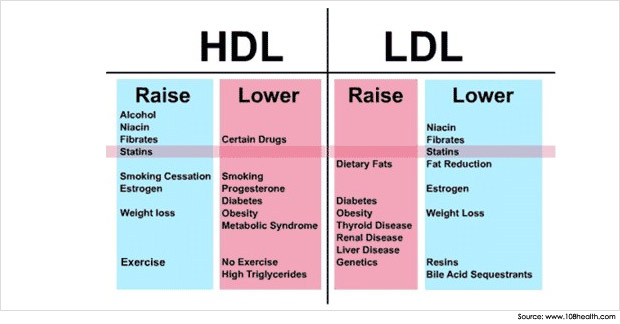Hdl Cholesterol Low
The Benefits of Raising Your HDL Cholesterol
HDL cholesterol (high-density lipoprotein) is the so-called good cholesterol in the blood serum. It is responsible for carrying excess cholesterol away from the body tissues and arteries back to the liver. The liver combines cholesterol with lipoproteins for use in various physiological body functions and building of tissues. A lipoprotein is a combined unit of lipid, that is, fat on the inside surrounded by protein on the outside.
Since cholesterol is water-insoluble, the blood cannot carry it unless it is turned into a water-soluble form. That is where water-soluble lipoproteins enter the scene. They combine with cholesterol to form water-soluble units that can move through the bloodstream.
These lipoproteins are mainly of two types: low-density (20-25% proteins) lipoproteins, LDL and high-density (40-55% protein) lipoproteins, HDL. Medical experts refer to the cholesterol transported by HDL as HDL cholesterol.
So, when medical experts talk of HDL cholesterol, they mean HDL-bound cholesterol. Scientifically speaking there is no such thing as "good cholesterol" or "bad cholesterol". Cholesterol is just cholesterol, a sterol lipid having the chemical formula C27H45OH. In fact, HDL and LDL are not cholesterol at all. They are just lipoprotein vehicles for carrying and moving cholesterol through blood.
Most people commonly call HDL good cholesterol because it travels from the arteries and body tissues back to the liver for recycling or elimination. This prevents a build-up of plaque (a hard fatty deposit) on the inner walls of major arteries supplying blood to the organs. This reduces clogging of the arteries and the risk of heart attacks, paralysis, and hypertension.
HDL Cholesterol
Scientists have recently discovered that low HDL cholesterol level in blood is an independent risk factor for these cardiovascular and crebrovascular diseases. HDL levels below 40 mg/dL for men and below 50 mg/dL for women are considered low. This is separate from the total cholesterol and LDL levels. This means that even with a normal total cholesterol count and a safe LDL level, people with low HDL cholesterol levels are at an increased risk of heart disease.
So the emphasis should not only be on lowering the total cholesterol and LDL levels, but also raising the HDL cholesterol level. Research has shown that a drop of just 1 mg/dL in the HDL cholesterol level can lower a person's risk of suffering a fatal heart attack by 3%.
But how does one raise the HDL cholesterol level while keeping the total cholesterol and LDL levels low? Ideally, an HDL more than 50 mg/dL for men and 60 mg/dL for women is considered heart-protective. Most people, however, can push the HDL cholesterol levels up by making some lifestyle and diet changes.
Hdl Cholesterol Low - List
Raising HDL Cholesterol
To raise your HDL cholesterol, take up an aerobic activity like walking, cycling, swimming or dancing for 30-40 minutes 5 times a week. Quitting smoking, losing excess weight and consuming foods rich in dietary soluble fiber, omega-3 fatty acids and antioxidants also raises the HDL cholesterol levels.
Another lifestyle change that is effective in raising HDL cholesterol is saying no to saturated and trans fats (red meats, egg yolk, butter, whole-cream dairy products, commercial bakery items, deep-fried foods, and so on). Instead go for a diet based on polyunsaturated and monounsaturated vegetable oils, whole grains, cereals, nuts like almonds and walnuts, flaxseeds, beans, legumes, lentils, fruits and vegetables.
HDL Cholesterol List:
- causes of low hdl
- hdl cholesterol low 35
- low hdl
- low hdl cholesterol levels
- low hdl level
- low hdl treatment
Learn more: Top 2 programs for Oxidized Cholesterol Strategy
